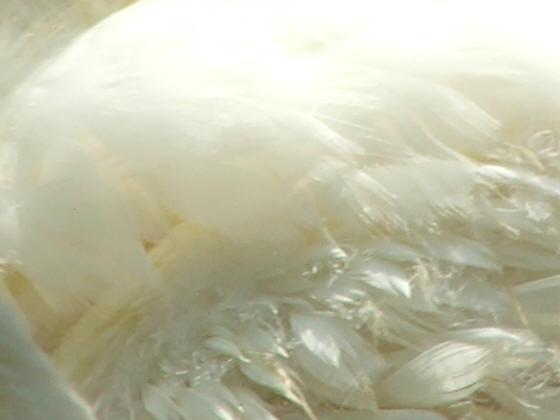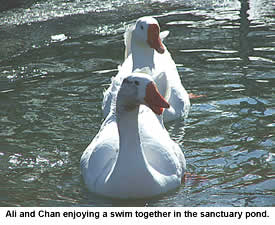|
In This Issue...
 |
All
You Ever Wanted to Know About Feathers |
 |
Majestic Welcomes Geese |
 |
Get to Know Your Predators: The Red-Tailed Hawk |
 |
The Month in Photos! |
 |
Reader Poll #15 |
 |
Recommended
Reading:
Duck & Goose
|
|
The Month in
Photos!

Riddles & Joker in a brotherly chat
Get to Know
Your Predators: Red-Tailed Hawk
Red-Tailed
hawks weigh anywhere between 2 and 4 pounds, females being
larger than males. They are very
aggressive raptors.
We frequently see these hawks in our area and they are
impressive. I have no doubts that they could take a small
duck, although they seem to be scanning for ducklings. We
have even seen them dog-fighting in the air with wild, adult
Mallard ducks who are protecting their ducklings.
Red-tailed
Hawks will take one of two tactics to catch their prey. They
will sit on a branch and scan the surrounding area for prey
or they will make flight patterns, back and forth over an
area in search of prey.
Reader Poll #15
Question: What are
some of your favorite movies that feature ducks, geese, or
swans in lead, supporting, or cameo roles?
Results of Reader
Poll #14 Would you
like us to devote a page on our website to recommended
movies about ducks and geese?
|
Yes, bring it on! |
100% |
 |
|
No Way! |
0% |
Recommended Reading*

Duck
& Goose
By Tad Hills
|
Ordering
information |
Description:
In this goofy
story, a duck and goose mistake a big spotted ball for an egg. Each
one claims it and they fight over taking care of it. In the end,
they realize their foolishness and become friends, enjoying their
ball together.
The themes of
getting along, sharing, and settling one's differences come across
loud and clear, and the author does a good job with the subject
without becoming too didactic. While the narrative is fairly
straightforward and has touches of childlike humor throughout, it's
the bright and colorful artwork that will attract youngsters'
attention. The cartoon-style oil paintings set against soft-focus,
almost impressionistic backgrounds keep Duck and Goose center stage,
and their expressions are priceless.
|
* |
For
our full recommended viewing/reading list, click
here. If you order from
Amazon.com by way of our web site, Majestic receives a
portion of the proceeds! |
Contact Us
Majestic Waterfowl
Sanctuary
17 Barker Road
Lebanon, CT 06249
directorATmajesticwaterfowl.org
Our Newsletter
The Majestic Monthly is published 12 times per year. Back
issues can be obtained online from our
Newsletter Archives.
|
|
All You
Ever Wanted to Know About Feathers
Ducks
and geese have five types of feathers:
1. Contour
Feathers
 |
Retrice (tail feathers) |
 |
Remige (wing feathers) |
 |
Regular (outer body feathers) |
Wing feathers
or Remige feathers are asymmetrical in shape. The vane on one side of the shaft is much narrower than the vane on
the other side.
Tail feathers or Contour feathers are symmetrical,
with the shaft traveling down the center of the vane. Contour
feathers cover the body of your duck and give them their shape and
color.
2.
Down Feathers
Down Feathers are
fluffy feathers found beneath the contour feathers. They provide
insulation.
3.
Semiplumes
Semiplumes are
found between the contour feathers they too provide insulation as
well as some shape.
4.
Filoplumes
Filoplumes are
very small and have only a few tufts of barbs at their tips. They
are believed to provide a sensory function, possibly helping ducks
keep their feathers in order.
5. Powder Feathers
Powder feathers
also provide insulation for your duck. They are found scattered
throughout your duckís plumage. They slowly break apart and
disintegrate into a powdery substance. This powder helps soak up
water, which makes it easier for them to preen.

Feather
Structure Basics:
The base of the
feather, where the quil is bare, is called the calamus. When the feather is alive the quill has a vein in it that
carries nutrients to the growing feather. At this stage of its
growth it is called a blood feather. When growth is complete, the
quill becomes hollow.
The calamus becomes
the shaft or rachis at the point where side "branches"
appear. The collective group of side branches on either side of the
shaft is called the vane of the feather.
The vane of the
feather is made up of what almost appear to be miniature feathers,
these are called barbs. These barbs have even smaller
branches that are called barbules. Barbules that neighbor
each other are lined with opposing hooks or barbicelli. These
hooks latch together which ducks and geese "zip" together with their
specially designed bills.
Majestic Welcomes Geese!
Majestic
welcomes its first domestic geese into the sanctuary! On the
Saturday at the start of the cold front, rescuers huddled on the
shores of a pond and waited for our kayaker Sharon to guide the
geese off of the water and into our arms. The two geese have been
residing on a pond wedged between a Home Depot parking lot and an
extremely heavy traffic route in Berlin, Connecticut.
After
consulting with the property owners and local authorities, we
believe that the geese have survived at this location for at least
2-3 years. We were recently contacted about the birds because they
had been spotted wandering dangerously close to incoming traffic to
the shopping plaza. In addition to this hazard, concerned citizens
reported that the geese had no protective shelter, that their bread
diet lacked nourishment and that one of the geese had some sort of
bill deformity.
Both geese were
safely removed from the pond within hours and brought to our
sanctuary. We suspect that ďAliĒ the blue-eyed, white and gray
gander is a Pilgrim mix. Ali has a very strange
deformity beneath his bill that almost appears to be a third bill.
He went to our waterfowl vet for a closer examination.
Our vet
determined that Aliís tongue is shorter than normal either because
of congenital defect or because he sustained an injury. The tongue,
being too short, rests incorrectly in the lower bill. The pressure
of having his tongue push down through his lower bill has caused a
pouch of skin to drop down under his bill. Aliís tongue rests in
this paper thin pouch, rather than resting properly in his lower
bill, as a longer tongue would. Aliís tongue gets stuck in this
pouch and food also gets trapped in this pocket.
What does this
mean for Ali? Well, it is vital that Ali has a constant supply of
very clean water available at all times, so he can effectively keep
this pouch clean. A clean pond is in Aliís best interests.
Our vet is
certain that if Aliís short tongue is not an inherited condition, it
is an old injury and that he's had it for at least a year, probably
longer. At this time he recommends that we do nothing. With any luck
and lots of fresh, clean water to keep the pouch clean, it should
never cause him problems. If it does cause him future troubles,
which he doubts, major surgery will need to be done to put a ceramic
plate in his lower bill to seal it up and then the excess skin
beneath it would need to be cut away.
Aliís was also
exhibiting a great deal of shivering in his right leg. Our vet
confirmed that Ali has no leg injuries; rather, it is one of the
first signs of malnutrition and oncoming lameness. Although pond
visitors meant well, the array of breads and iceberg lettuce being
offered just werenít providing them with the protein and vitamins
they needed to remain healthy and strong. When feeding waterfowl, it
is best to feed them actual duck food or, in its absence a small,
round and floating cat kibble.

Both
geese were immediately placed on a Mazuri Waterfowl Maintenance diet
(which all of our ducks enjoy as well). The geese are adapting very
well to life at the sanctuary in their spacious 25í x 35í
predator-proof enclosure. They enjoy frequent walks out to the new
sanctuary pond for swims.
|